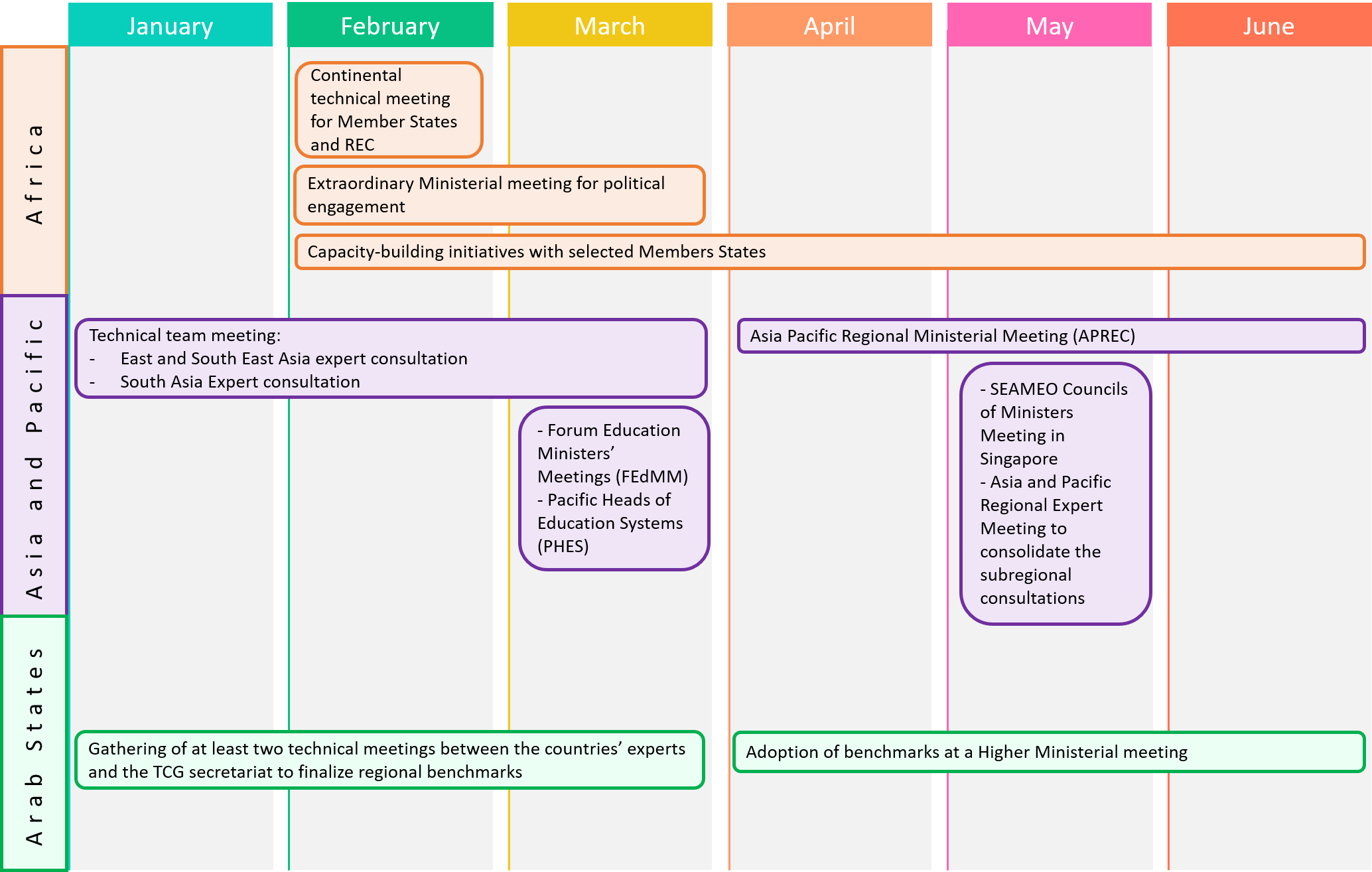Since the adoption of the 2030 Agenda for Sustainable Development, the Education 2030 Framework for Action called on countries to establish “appropriate intermediate benchmarks (e.g. for 2020 and 2025)” for the SDG indicators, seeing them as “indispensable for addressing the accountability deficit associated with longer-term targets” (§28). However, a majority of countries has not yet translated the global targets into specific ones to serve as references to report their progress in a regular manner.
To fill this gap and make countries accountable vis-a-vis the agreed global targets of the 2030 Agenda in education, seven global indicators were endorsed to benchmark the global framework against regional ones at the 6th meeting of the Technical Cooperation Group on SDG 4 (TCG) in 2019 in Yerevan, Armenia.
The extraordinary session Global Education Meeting in October 2020 reminded countries of their commitment to the Declaration, which called on “UNESCO and its partners, together with the SDG-Education 2030 Steering Committee, to … accelerate the progress and propose relevant and realistic benchmarks of key SDG 4 indicators for subsequent monitoring” (§10).
The effectiveness of the process to set, monitor, and act on benchmarks rests on two factors:

In response, countries and international governmental organisations have designed regional education plans to articulate the SDG 4 Targets.
The main objective of benchmarks is to draw attention to data gaps and introduce a coordinated mechanism to flag countries that may be falling behind in terms of certain key indicators.
Seven SDG 4 global indicators have been selected in the regional benchmarking process to take into consideration disparities of regions, sub-regions and countries.

The technical process for setting regional benchmarks is briefly presented here and is explained in greater detail in the following paper: Benchmarks for SDG 4 Indicators: A Political and Technical Basis for Discussion.
Technical process for setting regional benchmarks will serve 3 objectives:
 Proposed interim national benchmarks
Proposed interim national benchmarks
Until countries select their own benchmark for each of the seven SDG 4 Indicators, the following interim national benchmark approach is proposed.
Despite the fact that the two approaches differ, regions could opt for a variation that includes both approaches. The need for countries to take an active role in setting their benchmarks is envisaged in the Framework for Action.

Find out more here.


Publications
- Benchmarks for SDG 4 Indicators: A Political and Technical Basis for Discussion
- Available in English, French, Arabic, and Portuguese
- Establishing Regional Benchmarks for SDG4 and the Agenda 2063
- Available in English, French, Arabic, and Portuguese
- Continental Overview: Bridging CESA and SDG 4 in Africa, a report on the current progress of African countries in relation to the SDG 4 and the Continental Education Strategy
- Evidence-based Projections and Benchmarks for SDG Indicator 4.1.1, Information Paper No. 63 (January 2020)
-
Data
- Benchmark indicators Data Book
- CESA Strategic Objectives and Indicators Monitoring Global and thematic indicators for the SDG 4 by Country – (2010-2020)
- Global and thematic indicators for the SDG 4 by Country (Africa)– (2010-2020)
Blogs
- Bridging CESA 16-25 and SDG 4: Using Regional Benchmarks to Meet Education Objectives, by Silvia Montoya, Director of UIS and Daniel Capistrano, University College of Dublin
- Benchmarks: Using Data to Set Evidence-based Targets to Improve Learning Proficiency, by Martin Gustafsson, published on 30 January 2020
- Benchmarks: the forgotten commitment for accelerating progress towards SDG 4, by Silvia Montoya, Director of the UIS, and Manos Antoninis, Director of the Global Education Monitoring (GEM) Report, published on 19 December 2019
The UIS and the Chair of the UIS governing board convened the Norwegian Agency for Development Cooperation (NORRAD), the German Gesellschaft für Internationale Zusammenarbeit (GIZ), Bill and Melinda Gates Foundation and UNICEF to discuss the SDG 4 benchmarking exercise, and donors and partners roles on 17 February 2021.
Various areas were discussed and explored:
- Use the UIS benchmark dashboard to identify data gaps and drive coordinated investment in solutions;
- Identify where commitment and capacity need to be strengthened; and
- Identify the potential of regional data coordination initiatives to enable political engagement on data issues.
Presentation
Regional processes
Each region has its own framework to set, monitor and report on the benchmarks to achieve the SDG 4:

